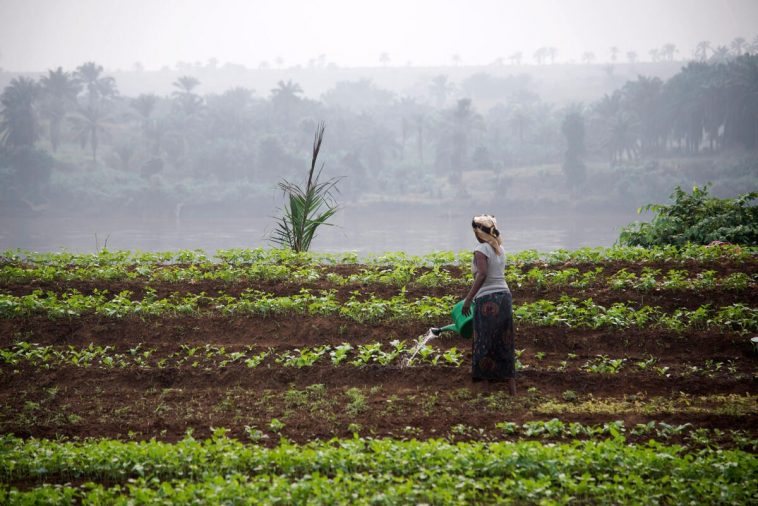The agricultural and livestock sectors offer major investment opportunities in the DRC. Arable land, less than 10% of which is currently farmed, has immense potential, with the potential to feed up to 2 billion people.
Agriculture
The sector contributed 0.4 percentage points to the DRC’s growth in 2023. Its added value increased by 3.3% in 2023, compared with 2.4% in 2022, driven by the acceleration in cash crop production. Long hampered by insecurity in certain production zones, the performance of the agricultural sector is also facing the effects of climate change.
Food crop production
Up to the end of 2023, food crop production has improved, with value added growing by 3.1% compared with 2.6% the previous year. Its contribution to real
GDP rose from 0.3 points to 0.4 points year-on-year, boosted by the agricultural campaign launched by the government as part of its Agenda for Agricultural Transformation (ATA-RDC) programme. This programme involved, in particular, the distribution of inputs to farmers. The added value of cash production increased by 21.1% in 2023, compared with a contraction of 9.7% in 2022.
This trend is due in particular to the dynamism of the cocoa sector, where production volume increased by 74.5%. Congolese producers have redoubled their efforts to increase export volumes of this product, following China’s decision to abolish taxes on certain taxable products, notably coffee, cocoa and palm oil, from six African countries, including the DRC. The measure, which affects around 98% of taxable products, has been in force since 25 December 2023.
The forests
With a surface area of 135.5 million hectares, the DRC’s forests cover around 52% of the national territory and play a crucial role as a reservoir of biodiversity, constituting the second largest expanse of forest in the world after the Amazon.
In 2023, activity in this sub-branch contracted by 28.3% after rising by 2.7% a year earlier. This decline is attributable to a lack of interest on the part of loggers in exporting logs, following the measures introduced by the government in recent years, notably the moratorium on the granting of permits to industrial loggers.
The government is committed to reviewing all forest concession contracts to improve the sustainable management of forest resources, in response to current environmental issues and challenges, particularly climate change. This approach underlines the importance of reconciling agricultural development with environmental conservation.
The Congolese forests represent 10% of the world’s tropical forests (the second largest, after Brazil) and 50% of Africa’s forests. These forests store around 140 gigatonnes of carbon dioxide (CO2), equivalent to three years of global CO2 emissions.
Livestock farming and fishing
Livestock farming, fishing and hunting grew by 3.0% in 2023, up from 2.6% the previous year. This development is explained in particular by the creation of an integrated landing stage in one of the country’s main ports and a poultry platform with a view to producing sufficient fish and chickens and thus reducing the volume of imports, according to the BCC. Of the 8 boats ordered by the country in Egypt, three are 25 metres long and weigh 112 tonnes, and were announced as being ready for transport to Boma.
Opportunities in the agricultural sector
The production and marketing of agricultural products offer major investment opportunities in the DRC. Arable land, of which less than 10% is currently exploited, has immense potential, capable of feeding up to 2 billion people. With 80 million hectares of arable land, including stretches of grassland and savannah suitable for livestock farming, and irrigation potential estimated at 4 million hectares, the DRC has significant assets for agricultural development.
Experts point to the availability of foodstuffs on the market, the large number of traders and the proximity of supply sources as strengths of the Congolese market. However, the deteriorating state of the roads is a major obstacle, with over 60% of the country’s agricultural feeder roads in a very poor state of repair. Some areas, such as Tanganyika (84%), Bas-Uélé (78%) and Kwango (71%), are particularly badly affected.
The challenge is to organise the 500,000 local producers, professionalise them by sector, and distribute the 4,340 items of agricultural equipment needed to develop collective fields totalling 43,000 hectares.
The government initiated the ‘local development support programme’, which has been rolled out in several of the country’s provinces. This programme has enabled farmers to obtain funds to acquire or increase their land.
Source: FAO, Ministry of Agriculture, Anapi, Annual Report 2023 BCC
Exergues
0.4 is the contribution of the agricultural sector to DRC growth in 2023
The cocoa sector is particularly dynamic, with a 74.5% increase in production volume in 2023.
In the DRC, 60% of the country’s agricultural feeder roads are in a very poor state.
The DRC’s forests, a reservoir of biodiversity, cover around 52% of the national territory, making up the second largest expanse of forest in the world, after the Amazon.


